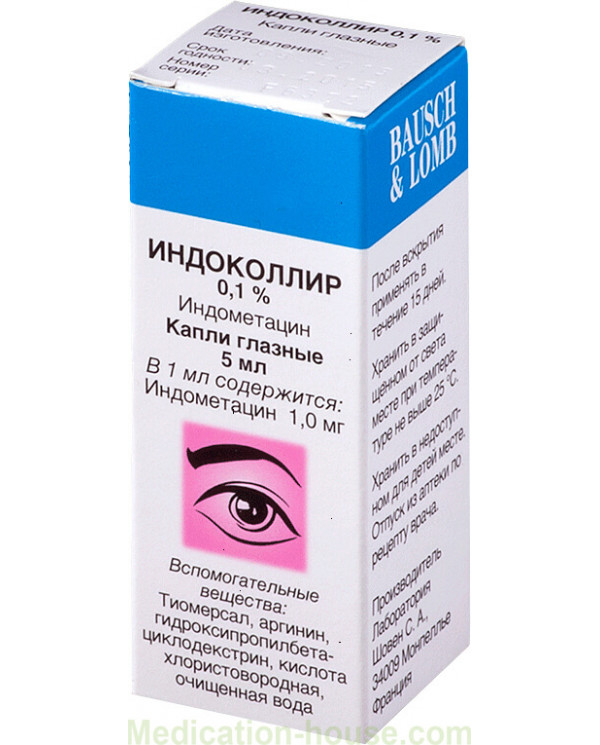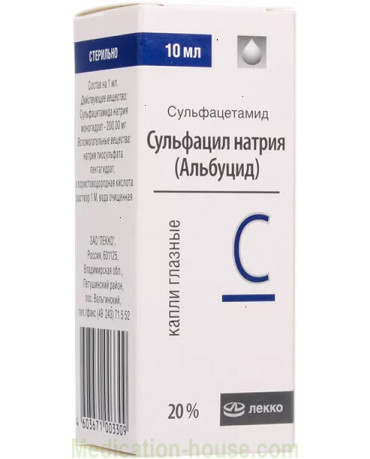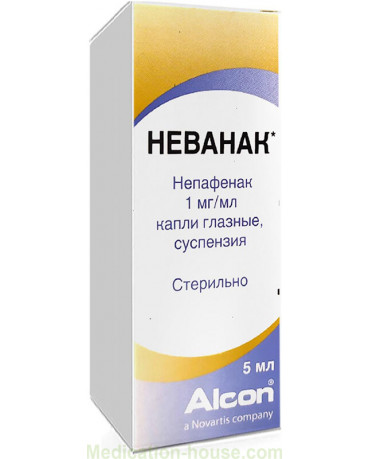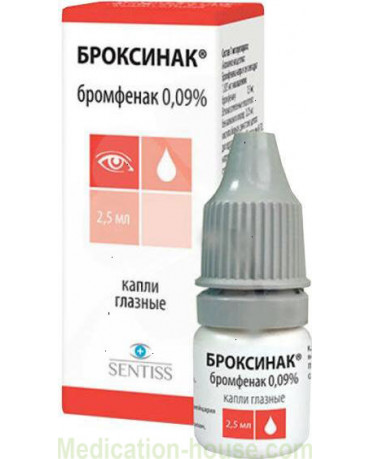Indocollir user manual
To buy Indocollir just add it to your shopping cart
Composition and form of release
Indocollir eye drops are a pale yellow solution without a specific odor. The active ingredient providing medicinal properties is indomethacin. The drops include as auxiliary substances:
purified water;
arginine;
hydrochloric acid;
thiomersal;
hydroxypropyl betacyclodextrin.
The solution is packaged in plastic bottles equipped with a dropper for easy dosing. The volume of the bottle is 5 ml.
Pharmacodynamics, pharmacokinetics
Indocollir eye drops belong to the group of non-steroidal anti-inflammatory drugs (NSAIDs), which have analgesic and anti-inflammatory effects. Due to the active component, the activity of cyclooxygenase decreases, the synthesis of prostaglandins is inhibited. These substances are the main ones in the development of inflammatory processes and the appearance of pain.
When applied locally, indomethacin reduces the severity of the process of inflammation and pain. This effect is associated with a decrease in the rate of occurrence and transmission of nerve impulses along nerve fibers. Also, the active ingredient reduces the synthesis of thromboxane A, which helps to thin the blood and reduce congestion.
According to research, the medication enters the anterior chamber of the eye. Immediately after local application, its components are found in the moisture of the anterior chamber of the eye after an average of 2 hours. Systemic absorption, that is, the penetration of the drug into the general bloodstream with local use is extremely low.
Indications for use
Ophthalmic solution is used for the following indications:
conjunctivitis of non-infectious origin;
inhibition of miosis during surgical interventions on the anterior chamber of the eye, including cataracts;
cystic edema of the macula after surgical procedures;
severe pain after photorefractive keratectomy;
surgical interventions for diseases of the eyeball (both with therapeutic and prophylactic purposes).
Indocollir is also used in combination with antimicrobial treatment of eye diseases associated with inflammatory processes after trauma and wounds of the organs of vision.
Contraindications
Anti-inflammatory eye drops should not be used for the following conditions and diseases:
a history of asthma attacks associated with the use of other NSAIDs and acetylsalicylic acid;
severe hepatic, renal failure;
third trimester of pregnancy;
stomach ulcer;
age up to 18 years, since there is no data on the effectiveness and absence of negative consequences;
breast-feeding;
hypersensitivity to the substances that make up the drops;
hypersensitivity to NSAIDs, acetylsalicylic acid and other salicylates;
parallel use of indirect anticoagulants, heparin, other NSAIDs, diflunisal, metatrexan, ticlopidine, lithium preparations.
Indocollir should be used with caution while taking:
diuretics;
methotrexate;
ACE inhibitors;
beta-blockers;
cyclosporins;
thrombolytics;
zidovudine;
agents that affect the mucous membrane of the gastrointestinal tract (salts, aluminum, calcium, magnesium oxides and hydroxides).
Also, caution is needed if there is a predisposition to allergic-type reactions.
Instructions for use
Before use, it is necessary to warm the drops in hands, but they cannot be placed on heating devices. When instilling, it is not recommended to touch the eyelids, skin with a dropper-nozzle, or touch it with your hands. To drip the solution, you need to slightly pull the lower eyelid with your finger and add the required number of drops into the conjunctival sac, that is, under the lower eyelid. To better distribute the solution, you can quickly blink or close your eyes and make circular movements.
The dosage and duration of treatment is set depending on the indications for use. In order to prevent macular edema after surgery, 1 drop is administered up to 4 times a day for 1 month. To inhibit miosis during surgical treatment, 1 drop is used every 30 to 40 minutes for 3 to 4 hours before surgery.
In order to prevent and treat complications of an inflammatory nature, including after surgery for glaucoma, 1 drop of the solution is instilled into the affected eye 4-6 times a day. You need to start using drops one day before surgery and continue to drip until signs of inflammation disappear.
To relieve pain in the eyes after photorefractive keratectomy, the drug is dripped 1 drop 4 times a day for 2 - 3 days, depending on the severity of the pain syndrome. In other conditions, eye drops are used 1 drop from 3 to 4 times a day, the duration of treatment is from 7 days to 1 month.
Use in pregnant women, nursing women, children
Ophthalmic solution is prohibited for children under the age of 18, since the manufacturer does not indicate data that prove the safety of use in children. Eye drops can only be used by pregnant women up to the 6th month of pregnancy. In the third trimester, its use is prohibited, since there is a risk of developing cardiotoxic effects.
Under the influence of indomethacin, the fetus may prematurely close the ductus arteriosus, and pulmonary hypertension may form. In addition, a decrease in kidney function is possible. The use of the medication in the third trimester increases the risk of developing edema in a pregnant woman. If you drip Indocollir before childbirth, then the duration of bleeding after, may increase.
NSAIDs, including the active substance indomethacin, pass into breast milk. Therefore, it should not be used during breastfeeding.
If the drug is necessary, and it is not possible to replace it with another remedy, then the baby should be transferred to artificial feeding. In order to maintain lactation, it is necessary to express breast milk. You can return to breastfeeding only after discontinuing the drug.
Compatibility with other medicinal products
The ingestion of the components of Indocollir drops into the systemic circulation is minimal, but despite this, when using, it is necessary to take into account their drug interaction with some drugs:
Other non-steroidal anti-inflammatory drugs, diflunisal, heparin, indirect anticoagulants. These agents, in combination with Indocollir drops, increase the likelihood of ulceration and bleeding, especially when combined with diflumitazole (although it increases the amount of indomethacin in the blood).
Methotrexate. When taken simultaneously with an ophthalmic agent, the elimination of Methotrexate slows down, which is dangerous by the development of a hematotoxic effect, when the agent is taken more than 15 mg / week. At a lower dosage, it is necessary to constantly monitor blood counts during the first 7 days of admission, as well as kidney function in elderly people.
Beta-blockers reduce the effectiveness of eye drops.
Pentoxifylline - increases the risk of bleeding from the gastrointestinal tract.
NSAIDs in combination with desmopressin increase its antidiuretic effect.
Cyclosporin against the background of Indocollir shows its nephrotoxic effect more strongly.
Ticlopidine, thrombolytics - increase the risk of bleeding.
Lithium preparations. The active component of eye drops increases its concentration in the blood, up to toxic, since they slow down its excretion from the body through the kidneys.
Zidovudine - can be toxic to reticulocytes, which can lead to anemia.
Medicines that have an effect on the lining of the gastrointestinal tract (such as aluminum, salts, calcium, magnesium hydroxides and oxides) reduce the absorption capacity of indomethacin.
The simultaneous use of drops with ACE inhibitors, diuretics can lead to acute renal failure, as the body is dehydrated.
If it is necessary to use several ophthalmic agents at once, especially which contain corticosteroids, it is necessary to keep the interval between instillations at least 15 minutes.
Side effects, overdose
During the existence of Indocollir eye drops, there have been no cases of overdose. If a person has dripped more drops than indicated in the instructions, it is necessary to rinse the eyes with plain warm water. If the solution is accidentally drunk, symptomatic treatment is prescribed.
Side effects are rare and almost always occur from the side of the visual organs:
itching or burning in the eyes;
redness of the conjunctiva;
temporary loss of vision clarity;
excessive light sensitivity;
punctate superficial keratitis.
In extremely rare cases, ulceration of the cornea with its subsequent perforation is possible.
Special instructions
Thiomersal is included in the eye drops, which can provoke allergic reactions. If symptoms of allergies or side effects develop, instillation should be discontinued and an ophthalmologist should be consulted. Non-steroidal anti-inflammatory drugs, including Indocollir, can reduce the regeneration of corneal cells.
With the parallel administration of lithium preparations, it is necessary to constantly adjust their dosage throughout the course of treatment, depending on the amount of lithium in the blood plasma. When using NSAIDs after surgical manipulations on the eyeball, it should be borne in mind that this group of drugs lengthens the bleeding time, especially if a person has diseases associated with impaired blood coagulation or the patient is taking anticoagulants.
If eye drops are used in conjunction with diuretics and ACE inhibitors, it is necessary to monitor kidney function and prevent dehydration. With the combination of Indocollir and indirect anticoagulants (as well as heparin or ticlopidine), it is necessary to constantly monitor blood counts, or rather the clotting rate.
If a person wears contact lenses, then they must be removed before instillations. You can put on the lenses again after 15 to 20 minutes. After instillation, sometimes there is a loss of clarity of vision. In this regard, immediately after using the product, it is not recommended to get behind the wheel and start work, which requires attentiveness and clear vision.
Expiration date, storage conditions
Eye drops are stored out of reach of children, protected from sunlight, at temperatures up to 25 ° C. The duration of the preservation of the therapeutic effect is 1.5 years from the date of manufacture, which is indicated on the carton and bottle. After opening, the medication can be used for no more than 15 days.
Reviews
Anatoly, 29 years old
I used Indocollir drops when I was injured at work - when I was sawing a tree, chips flew off. There was no time to go to the doctor, so I just rinsed my eyes with water. During the day, the eye did not bother, just a little reddened. The next day, the redness intensified and pain appeared. I went to an ophthalmologist, he prescribed these drops for me. In general, I was satisfied, the pain went away, the redness too.
Snezhanna, 35 years old
A year ago I underwent retinal surgery - diathermocoagulation. Before and after the operation, I was prescribed to drip Indocollir into my eyes. The doctor said that they help reduce the risk of complications after the intervention, such as inflammation, and also relieve postoperative pain well. Indeed, there was no inflammation after the operation. Pain after instillation began to disappear after about 5 minutes. Therefore, I find the drops to be very effective.
Andrey, 44 years old
Last year I had a keratectomy and so I was prescribed Indocollir drops. I used this remedy before the operation, when I got an eye injury. I didn’t go to the doctor right away and my eyes became very inflamed, in the morning I could not even open it, and the drops did an excellent job in 7 days. And after the operation, they very quickly relieved the pain, literally 2 - 4 minutes. I had no side effects, as well as discomfort after instillation.
Terms of sell
You can buy Indocollir without a prescription.




